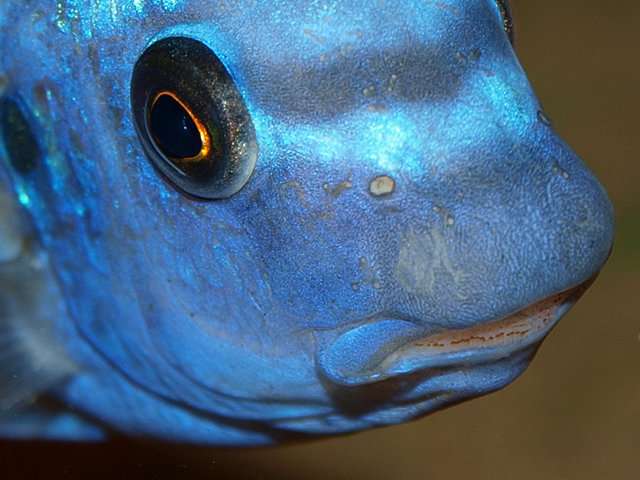
An African cichlid fish with an extra large snout. In PNAS, UMass Amherst biologists offer evidence that the evolution of such a trait is due in part to increasing the expression of core members of an existing gene network. The snout hangs over the animal’s upper jaw and teeth and helps them to pry tough algae from rocks. Credit: UMass Amherst
There has long been a debate among biologists over whether the evolution of new traits requires new genes to evolve or whether they can arise simply from the recruitment of existing genetic pathways, says developmental biologist Craig Albertson at the University of Massachusetts Amherst.
“Where do novel traits come from?” Albertson asks. “This question has been around for centuries, but we’ve only really had the tools to address it for about 10 or 20 years. Do they require drastic genomic changes, or is it more about tinkering?”
Now, results from what he calls an “elegant set of experiments” in African cichlid fishes performed by his graduate student Moira Conith support the idea that novel traits can come from expanding gene-regulatory modules that have always existed in an organism. Details appear in Proceedings of the National Academy of Sciences.
“While the recruitment of existing molecular pathways has been demonstrated in invertebrates, examples in vertebrates are rare,” Albertson points out. “We now have solid evidence that the evolution of this bizarre trait is due, at least in part, to increasing the expression of core members of an existing gene network.” The bizarre trait in this case is a grossly enlarged snout that hangs over the animal’s upper jaw and teeth, which helps these fish pry tough, filamentous algae from rocks.
The researchers show that the cichlid snout is composed of two tissues, the intermaxillary ligament that connects the right and left sides of the upper jaw, and overlying loose connective tissue. The ligament is present in all cichlids, but in the fish with extra-large snouts, these tissues are hugely elaborated and intertwined, with the ligament anchoring to the skin, forming a unique ligament-epithelial complex.
Albertson explains, “Ligaments normally connect bone to bone, and this unique anatomical configuration is likely an important feature for feeding in these animals.” He speculates further that the ligament helps to stiffen the snout. “When feeding, these fish press their snout against the lake floor, protrude their jaws from beneath it, take a mouthful of algae, and then rip the algae from rocks as their jaws retract back to their skulls. All of this can happen without the fish needing to move their body, which means they can feed with far less energy exerted compared to fish without large snouts.”
Suspecting a candidate gene-regulatory network known to be involved in ligament development that includes the Transforming growth factor beta (Tgfβ) pathway and Scleraxis (Scx) transcription factor, Albertson and Conith designed a set of experiments that involved protein manipulation, gene expression and genetic mapping. “She found that not only are these factors expressed at higher levels in fish with large snouts,” Albertson says, “but experimentally manipulating Tgfβ signaling in fish without snouts is sufficient to grow a thicker ligament and larger snouts.”
The researchers used genetic mapping to see whether the specific mutations that would lead to the development of an enlarged snout were correlated with Tgfβ pathway members. “It turns out they were,” Albertson says. “While we did not find strong evidence in support of mutations in or around Tgfβ, which works to signal between cells, we did for pathway members working inside the cell. Both the ligament-specific transcription factor scx, as well as signal transducers known as SMADs that work to transcribe or ‘turn on’ scx, were implicated by our genetic mapping study.”
Further, genetic mapping implicated a protein known as Adam12, which had never been shown to be involved in ligament formation before, a result they confirmed in the zebrafish model, he adds. Taken together, the experiments funded by the National Science Foundation, support the hypothesis that the Adam12-Tgfβ-Scx pathway is a pre-existing genetic module for ligament development that’s been recruited for the evolution of large snouts in these fishes.
“In terms of the Tgfβ-Scx pathway, it was already known to be involved in ligament and tendon development. Basically what we show is that this jump in evolution is due to simply cranking up this developmental pathway. It is a relatively simple molecular change that gave rise to a fairly elaborate phenotype,” Albertson says. “For Adam12 we are offering a totally new player in ligament formation, and so by studying this bizarre trait we have learned something new that should be of general interest to the community.”




